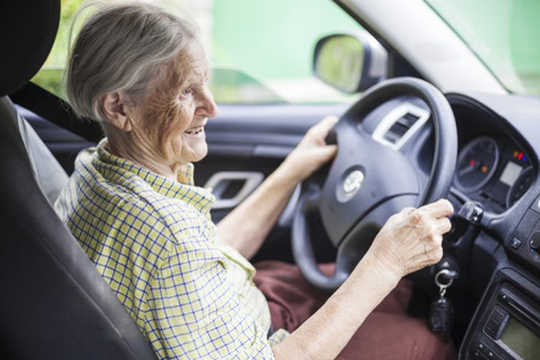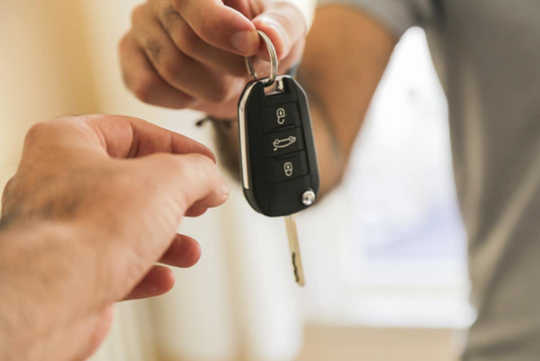
Older drivers are typically good drivers, but they can have impairments they may not recognize. Photobac/Shutterstock.com
When Britain’s Prince Philip crashed his Land Rover into another vehicle on Jan. 17, 2019, many people were surprised that he was still driving at age 97. Many thought that surely someone – the queen perhaps? – would have persuaded him to give it up, or would have “taken away” the keys.
Older unsafe drivers are a growing problem, thanks to the baby boom generation. In the U.S., 42 million adults 65 and older were licensed to drive in 2016, an increase of 15 million from 20 years ago.
Yet who wants to stop driving? It is not only a major symbol of independence but also a needed activity for older people to be able to shop, go to the doctor and maintain social connections.
I’m a geriatrics specialist physician, a daughter of parents who had to stop driving. I live in Florida, where 29 percent of our drivers are older adults, which everywhere else in the U.S. will experience about 10 years from now. I also serve as editorial board chair of the Clinician’s Guide to Assessing and Counseling Older Drivers, a collaborative project between the American Geriatrics Society and the National Highway Traffic Safety Administration, or NHTSA. I have spent a great deal of time training clinicians how to detect and treat factors leading to the loss of driving skills early enough to prevent crashes and the loss of independent mobility.
Older drivers by the numbers
By 2030, NHTSA estimates that 1 of out of every 4 drivers will be an older adult.
About 7,400 adults ages 65 and older were killed, and more than 290,000 were treated for motor vehicle crash injuries in 2016 alone.
Males 85 years and older and 20-24 years of age have the highest crash rates. Age and experience may be a factor here, but far and away the greatest number of vehicular deaths are still from substance abuse-related crashes, accounting for 23,611 out of a total 37,133 deaths in 2017.
According to Centers for Disease Control and Prevention data, most older drivers have good driving habits. The CDC reports that many self-restrict their driving to conditions where they feel safe and confident, such as avoiding high-speed roads, nighttime driving, bad weather or high-congestion times of day.
Know the stop signs
 Good driving skills, such as having good vision and range of motion, are more important than age. Nikolai Kazakov/Shutterstock.com
Good driving skills, such as having good vision and range of motion, are more important than age. Nikolai Kazakov/Shutterstock.com
Prince Philip announced on Feb. 9, 2019 that he would give up his driver’s license, but only after he and others had suffered serious consequences.
So how can others know when it’s time to get help or stop driving, for ourselves or for our parents, friends and neighbors?
It is all about the skills, not the age.
Key warning signs that it may be time to stop include getting lost, failing to obey traffic signals, reacting slowly to emergencies, using poor judgment, or forgetting to use common safety strategies, such as checking for blind spots.
Vision, cognition and the physical ability to manage the controls to the vehicle are critical functions that we must be able to perform, whether we are young or old in order to drive safely and effectively. Vision is well-recognized as the single most important source of information we use when navigating and making judgments.
Having difficulty with daytime sun glare, as was reported in Prince Philip’s crash, or nighttime headlights, brushing into objects on one side, or having to brake suddenly may be signs that something is impairing our ability to perceive road hazards accurately. Regular vision checkups are important to assure that we keep optimal vision for driving.
Cognition is essential to processing all the information we receive, ignoring distractions, remembering our route, responding to traffic signals and making good decisions. Medications and medical conditions such as sleep apnea, Parkinson’s disease or dementia can stop us from being able to think and respond well enough to keep ourselves or others safe while driving. Getting a good evaluation from your health care provider can help to minimize these risks and flag situations.
Physical abilities such as turning the steering wheel, neck flexibility and detecting where the pedals are correctly are important for operating the vehicle smoothly. Many of the same conditions associated with falls are also related to motor vehicle crashes.
Possible solutions
People can take brief self-assessments to get an idea of how they are doing, or ask a trusted individual to rate their driving using a tool validated by on-road testing, and discuss the results.
A driving rehabilitation specialist may be helpful in identifying problem areas, learning strategies for improvement and rehabilitating rusty or lost driving skills. You can find one using national databases on the America Occupational Therapy Association or the Association for Driver Rehabilitation Specialists websites.
It may be tempting to get a new vehicle featuring the latest safety features such as collision avoidance sensors, but these are not a substitute for a driver’s own skills. And, sometimes changing vehicles may even create mild confusion in a driver accustomed to a certain vehicle.
‘Mom, can I take away the keys?’
 Taking away the car keys could be avoided with earlier discussions about safety and cognition. fatir29/Shutterstock.com
Taking away the car keys could be avoided with earlier discussions about safety and cognition. fatir29/Shutterstock.com
Adult children often want to protect their parents if they notice impairment. It’s important to have open, respectful communication to establish that maintaining mobility and finding alternative means of transportation are key to retiring from driving. These discussions should occur long before there’s a crisis.
Being willing and able to stop driving requires having a realistic mobility plan. National and local transportation resources can help people get around without driving, but it does take some effort to get used to planning activities well in advance. New skills may be needed, such as learning how to access ride-hailing services like Uber or Lyft, or someday, managing an autonomous vehicle.
Until then, following basic driving safety strategies and keeping as mentally and physically fit as possible is the best way to help us help ourselves to keep driving for longer.![]()
About The Author
Alice Pomidor, Professor of Geriatrics, Florida State University
This article is republished from The Conversation under a Creative Commons license. Read the original article.
Related Books
at InnerSelf Market and Amazon
























